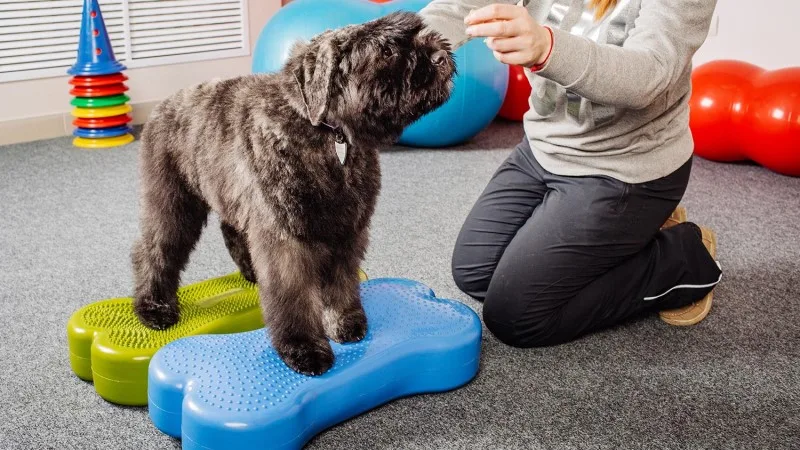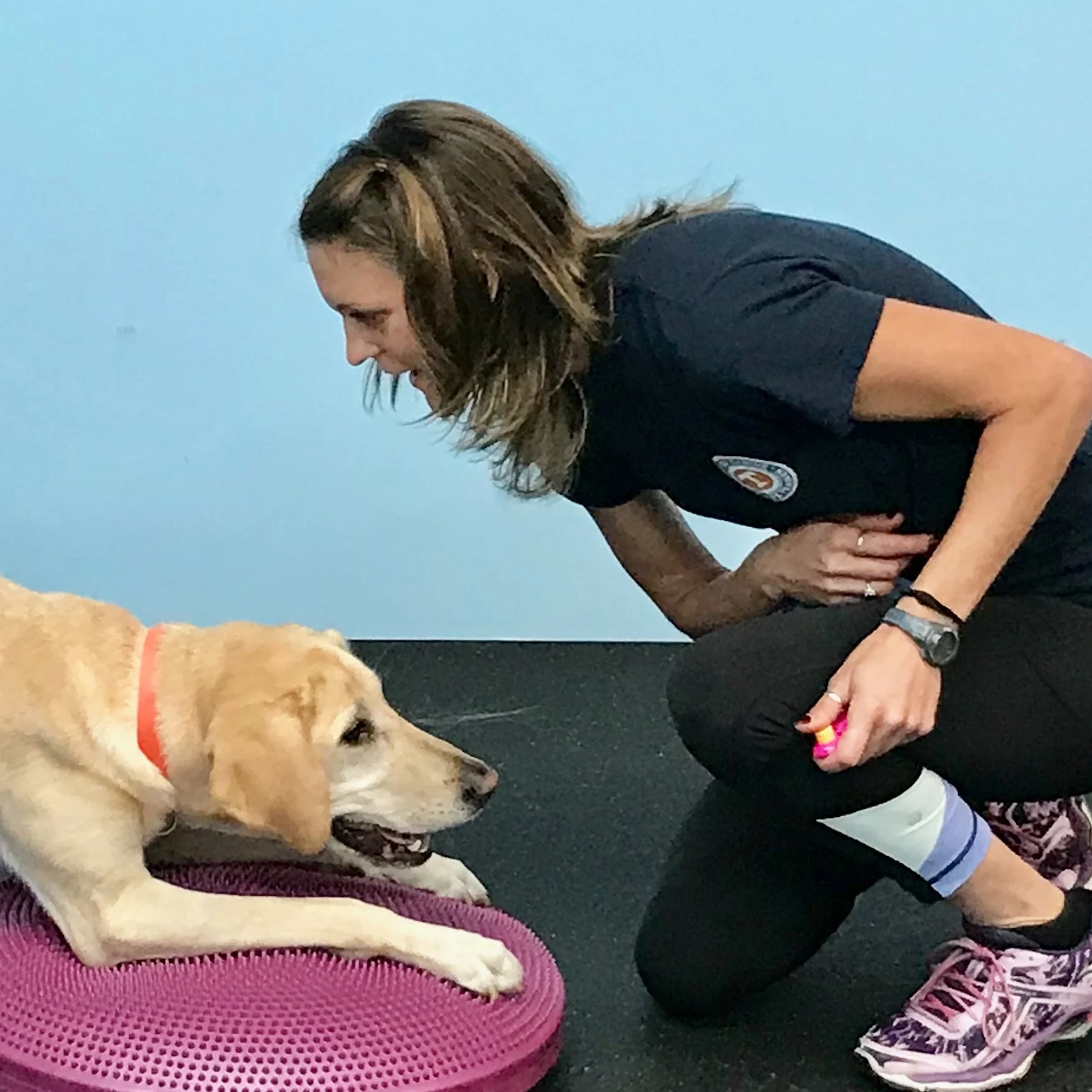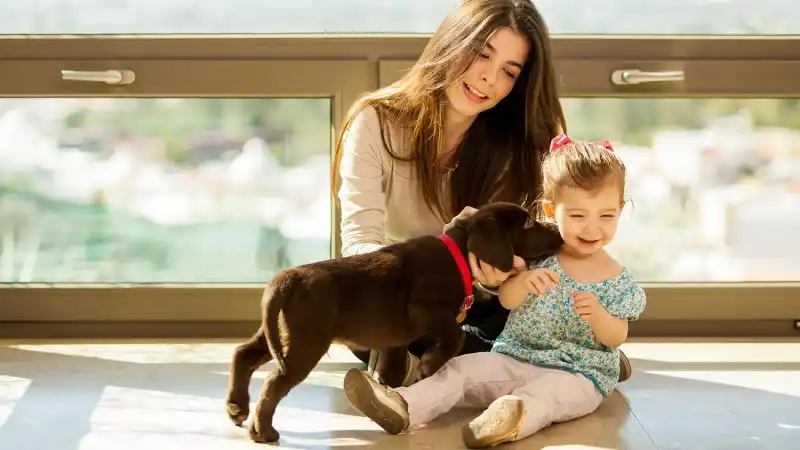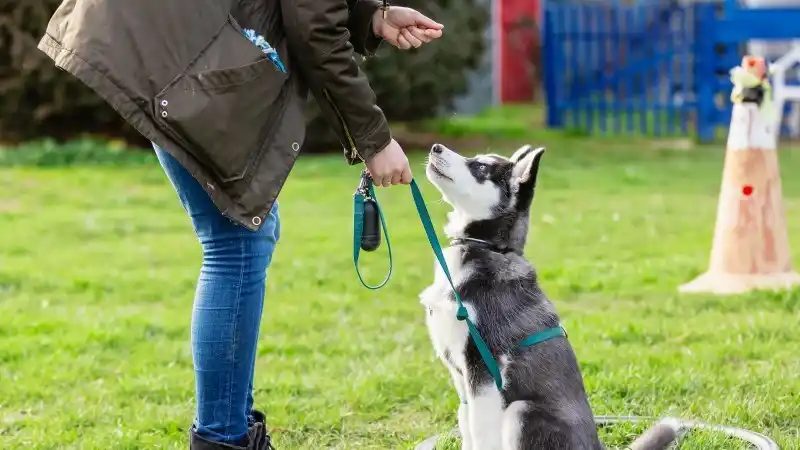Canine Fitness: Teach Your Dog Lateral Walking
Teaching your dog to lateral walk can help to prevent injuries and strengthen important muscles! Canine fitness can also help you to bond with your dog!

Help your dog get stronger and prevent potential injuries by adding sideways walking to his training and exercise regimen!
Why Teach Lateral Walking?
Sideways motion, called adduction and abduction, may help your dog prevent shoulder and knee injuries. Strengthening the small stabilizer muscles in the limbs enables your dog to better change direction suddenly while wrestling with another dog, avoid potholes or tree roots on a walk or hike, regain his balance after a stumble, or come safely down the stairs. In addition, learning to move his body deliberately and with control uses a lot of mental energy. A tired dog is a good dog!
How To Teach Lateral Walking
Lateral stepping means that your dog walks sideways in shuffle steps - think “step-together-step.” His spine stays neutral, which means fairly straight and not curved. To walk to his left laterally, your dog will need to move both left legs and then both right legs and repeat. Check out this previous blog on beginning lateral stepping for basic instructions. In addition to those tips, you may also want to create “highway lanes” (or foot targets) for your dog’s paws. Use a textured or nubby surface, such as two yoga mats set side-by-side lengthwise or two rows of Flexiness SensiMats, for your dog’s feet so your dog can see and feel a “target.” His front paws will be on one lane and his back paws will be on the other parallel lane. These lanes give your dog’s paws a pathway.
Teaching Your Dog to Step with You
After your dog is happily walking sideways with your guided walking, the next step is to have your dog learn to laterally walk with you facing your dog. If using highway lanes helped, continue to use those. Face your dog and walk your own legs in a tiny shuffle step to the side. Wait for your dog to follow suit by lateral stepping while facing you. Be sure to mark (say “yes”) and reward (give a treat) rear paw movement as often the hind limbs are the lagging portion of the body once the human moves in front of the dog. Keep your hips and feet facing your dog, but use your shoulders to steer your dog’s limbs into lateral walking if needed.
You may also find that using a chin hold or sustained nose touch hold assists your dog in lateral walking with you facing the dog. Have your dog facing you and request the chin or nose hold position. You should take a small shuffle step to the side and when your dog follows, say “yes,” release your dog (“ok”) from the chin or nose target position, and provide a treat. Over time, ask for more and more sideways steps while your dog holds the targeting position. Be sure to work both directions equally.
Some dogs do well using one or two long aerobic step benches as the race track lane for the front paws. Have the front limbs elevated onto a step bench during the lateral walking as the human faces the dog; the hind limbs should be on the floor or on a flat “lane” of a yoga mat or other mats. As a bonus, this shifts some weight into your dog’s hind limbs and further focuses on strengthening the hind limbs. Remember, dogs naturally place 60-70 percent of their body into their forelimbs.
After your dog is fluent in the physical mechanics of the skill, add a verbal cue “lateral” with an open hand (facing your dog) near your hip towards the direction in which you’d like your dog to lateral walk. Take a step in the same direction as your dog while remaining facing your dog.

Every Dog and Cat Deserves the Pet Insurance of Champions
Get prize-winning care for your pets.
How to Increase Difficulty
Use unstable objects, such as a row of sofa cushions or K9FITbones, under the dog’s forelimbs or hindlimbs. You may also do lateral walking on a gentle incline and decline – perhaps your backyard has a small slope? Consider using the curb during a walk for ten feet of lateral walking with the forelimbs elevated! Finally, have your dog walk sideways over a pool noodle, golf club, or cavaletti rail so that he must pick up his feet a little higher and further engage his core and stabilizer muscles.
How to Do Ipsilateral Stands
Lateral walking is often the first step in learning ipsilateral stands. An ipsilateral stand means your dog stands with same-side feet up on an elevated object! Thus, your dog could have his left two paws on the floor and his right two paws on an aerobic step bench. That shifts weight to the left side and your dog learns to balance! You would work both sides and hold the ipsilateral stands for 5-10 seconds with 2-3 sets. Later you could use more unstable equipment, such as an inflatable object like the Giant K9FITbone, a foam dog bed, or a sofa cushion.
To teach the ipsilateral stand, have your dog laterally step over the step bench slowly. Your dog will face you, starting with all four feet on the ground. He then should walk sideways over the step bench, pause in a stand position with all four feet on the step bench, and then continue to walk sideways to have all four paws on the floor. Repeat this in the opposite direction. As your dog acclimates to this challenge and gains strength, you can start slowing your dog down so that he pauses in the ipsilateral stand. Feed your dog while he is in the ipsilateral stand in both directions. Eventually your dog will realize that same side paws up on an object is quite valuable and earns him food and praise! You may eventually name this cued position with “sideways,” “electric,” or ‘straddle.” It is often helpful to give a body cue to your dog – consider straddling your legs when you are facing your dog so that he knows that he, too, should straddle in abduction and do an ipsilateral stand.
What’s Next?
Stay tuned for more fitness blogs! In addition, to find classes near you or to learn more about how to safely do beneficial calisthenic choreography for your dog, find a Certified Canine Fitness Trainer (CCFT). A CCFT can guide you in program design and in the proper number of repetitions and sets per exercise.
Besides being a blast, doing canine fitness helps keep your dog at anappropriate weightand physically fit. Doing fitness exercises with proper form can help prevent injuries and ensure your pup recuperates faster when he does get injured. Just as humans check with their doctors before engaging in new fitness routines, dog owners should check with their veterinarians before proceeding. If you ever see any changes in your dog’s health or notice any discomfort, stop the activity and contact your veterinarian.

Jasey Day holds the Certified Canine Fitness Trainer (CCFT) credential through the University of Tennessee. She is a member of the Bobbie Lyons K9FITteam - a team of compassionate canine fitness instructors who actively teach others and continually expand their own knowledge. Since 2004, Jasey has taught a variety of workshops and classes on the following: Puppy, Canine Good Citizen/Family Pet, Advanced Family Pet, Canine Fitness, Canine Swimming, Rally, and Agility. In addition, Jasey has earned over 60 titles in Dock Diving, Agility, Rally, CGC and Trick Dog. Jasey has worked full time for the American Kennel Club since 2007 and teaches at Care First Animal Hospital in Raleigh, NC. Jasey’s Labrador Retrievers spend their free time hiking, training, and snuggling with Jasey.
READ MORE ARTICLES

